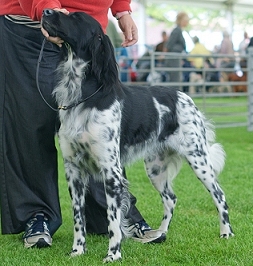Irish spotting (si) is the pattern sometimes known as “boston” or “mantle”, although these terms do not always refer to “true” irish spotting. On a dog with irish spotting, white is found on the legs, the tip of the tail, the chest, neck and muzzle. Many dogs with this pattern have a full white neck ring and a blaze.
White spotting on dogs is mostly determined by the genes on the S locus. When we use the term “white spotting” we simply mean white areas, not actually white spots. White spotting can occur on any colour, and will cover up both eumelanin and phaeomelanin. In technical terms this is known as epistasis. So any dog can have white markings, whether they’re black, blue, liver, isabella, brindle, sable, tan-pointed, merle or whatever.
Finally, a “flashy” irish spotted dog (one with more white than usual) may be caused by a combination of si and sp. If a true irish spotted dog also carries an sp allele then the normal white pattern may be extended. This supports the theory that si is actually on a different locus, as the two alleles appear to be inherited completely separately. This has been shown to occur in Shelties, where dogs carrying the sp allele as well as irish spotting can usually be identified by having more white around the neck and underside of the body. An spsp Sheltie has a high amount of white and is known as a “colour-headed white”. Shelties are one breed known to carry both true irish spotting and the sp allele, but many breeds only have one or the other.

 Believe it or not, the two Australian Cattle Dogs above are extreme white piebalds. The solid black patches on their heads are their actual markings, and the solid appearance of the rest of the coat is created by very heavy roaning. The Large Munsterlander to the right shows heavy ticking on a piebald dog.
Believe it or not, the two Australian Cattle Dogs above are extreme white piebalds. The solid black patches on their heads are their actual markings, and the solid appearance of the rest of the coat is created by very heavy roaning. The Large Munsterlander to the right shows heavy ticking on a piebald dog.
“Pseudo” irish spotting may look the same or very similar to true irish spotting, but is in fact not caused by sisi but by Ssp, i.e. these dogs are heterozyous piebalds. The incomplete dominance of S means that an Ssp dog may show up to roughly half the amount of white as an spsp dog. These dogs do not breed true and when two are crossed the puppies may be solid, piebald or inbetween. See below for an example of this in Boxers.
Why do black dogs have white chests?
Why do some black dog breeds have a white patch on their chest? It all comes down to genes and it is these genes that dictate how the pigment is spread in a dog’s skin and coat. The color of a dog’s coat is determined by the quantity of pigment present in the hairs.
Why Does My Black Lab Have A White Chest?
The Labrador breed coat color is the result of gene interaction, and the presence of certain alleles. We will look into the genetics of coat color in more detail a little later. But let’s take a look now at where these genes could be inherited from.
Labrador Retrievers have a long history that starts in Newfoundland, Canada. The ancestor of the Lab was a breed called the St John’s Water Dog. Although this breed is now extinct, there are plenty of photos available of the St John’s Water Dog.
This old breed had a thick black coat. In appearance, it is similar to the modern Lab, and the modern Border Collie breed! This is because it had an abundance of white markings amongst its darker fur, predominantly on its chest, face, and feet.
So, these markings were predominant in the Lab’s ancestor. As the breed was being standardized, a black Lab with a white chest wasn’t unusual. In fact, initially, white markings on black Labs were more common than the other fur colors, chocolate and yellow. Until 1892 all Labs were black, but some had white markings.